Anyone who watches Big Bang Theory will get the reference noted in the title of this post. Anyone who doesn’t watch Big Bang Theory should really watch Big Bang Theory.
The other day we went to a Cheetah Outreach here in Somerset West, fairly close to our house. There are a lot of opportunities to see animals here in South Africa, both in their natural habitat or through a man-made encounter created for curious well-paying guests. We don’t really like the man-made kind partly because it’s just not as rewarding and also because we don’t think it’s good for the animals. So we research our animal encounter options carefully and try to do the right thing in choosing where to spend our money. We were told that the Cheetah Encounter was an organization worth supporting and it was a highly educational and enjoyable experience. Based on our afternoon there, that is all true.
Before we tell you about our time there, first it’s time for your homeschool. Here are some Cheetah Facts:
- The fastest land animal in the world is losing its most important race: the race for survival. At the turn of the century an estimated 100,000 cheetah lived in 44 countries throughout Africa and Asia. Today, there are an estimated 7,100 cheetahs in 33 populations left in the wild.
- The primary reason for the cheetah’s decline is shrinking range due to habitat loss throughout Africa. Drastic increases in human population and proliferation of domestic animals has led to loss of habitat and prey, and increasing conflict with man.
- Because it is low in the predator hierarchy, the cheetah faces competition from other predators and does not do well in parks and reserves with large lion and hyena populations. Competition with other large predators takes the form of direct predation on cubs, occasional killing of adults, and loss of kills. As a result, more cheetahs live outside protected areas where they come into conflict with farmers.
- Being a daytime hunter, the cheetah is an easier target than other predators for harassment by tourists. In many parks and reserves, tourist vehicles routinely disrupt cheetah hunts.
- Past capture of wild cheetah for private use has led to the near extinction of the Asian population. Cheetahs don’t breed well in captivity and removal of individuals reduces genetic diversity in the wild.
We were so surprised about cheetahs being low on the predator hierarchy. In the media they are made out to be these fast, aggressive animals that’ll tear you up and eat you for lunch. But in fact they tend to be the late ones to the party, eating what another animal has already taken down, and that’s if they make it to the party at all.
So now that we know they are in serious decline, what to do? This organization we visited looked at the various reasons why the numbers were declining and felt that they could have the biggest impact in the area of the farmers. Farmers will often set out live traps or poison to trap and kill the cheetah to protect his livestock from being killed. However, the cheetah is rarely the animal that kills the livestock, being a fairly lazy predator. But the farmer usually catches the cheetah eating from the carcass that OTHER predators killed because the cheetah is active during the day when the farmer can see what’s going on. So the cheetah gets the blame for the kill even though it was most likely killed by a nocturnal predator the night before. So the farmer sees the cheetah as his enemy and tries to kill it. Poor cheetah, being blamed when it wasn’t his fault!
This organization looked at other ways the farmer could protect it’s livestock, both from the cheetah but also from the other animals that were doing the killing, including lions, hyenas, serval (who is quite often mistaken as a cheetah due to it’s similar markings) and wild dogs. So the outreach tapped into the natural instinct of the Anatolian Shepherd dogs and began a breeding program to supply farmers with these excellent watchdogs for free. The farmer, in exchange, agrees that he will not set out any traps or poisons for cheetahs and will remove any that are currently on the property. This was a very good arrangement that seems to be working quite well. The farmers report that the dogs are excellent workers and offer a much better protection than the trap and poison methods. In addition there are no cheetahs (or other predators) being killed by these farmers any longer.
When we read about the organization we envisioned dog handlers working with the dogs daily to train them on how to protect the herd. Turns out the dogs really needed no training, their instincts for defending their herd are that strong. From the Cheetah Outreach website:
The amazing ability of Anatolians to protect livestock stems not only from their physical attributes—size, strength, good eyesight, sharp hearing and excellent sense of smell—but from their familiarity with and dedication to their charges. Puppies are raised with the herd from 6-8 weeks of age and instinctively bond with the sheep or goats they are kept with. They are calm, confident dogs that continually stay with the herd and are very sensitive to changes in normal herd behavior or routine.
Anatolians will investigate and aggressively confront any intruders or threats to the herd. These dogs are not dependent on their masters for affection or direction, and are capable of making independent decisions. Anatolians possess the three main behavioral traits that an effective livestock guarding dog must have: trustworthiness, attentiveness and protectiveness.
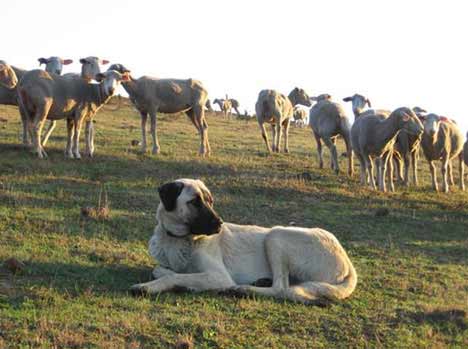
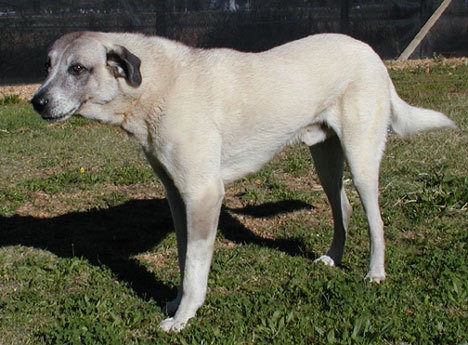
We were told of a situation where the dog was injured in a fight with a cheetah while defending the herd and required some stitches to heal. The dogs normally sleep and live with their herd, they do not live with the farmer. All the farmer does is take food to the dog and that’s about the extent of the connection between the farmer and the dog. But that night the dog was kept at the farmer’s house to aid in the recovery from his injuries. But the dog felt that he had a job to do so he broke out of the house, walked 14 km to his herd and resumed his post. The instinct to protect his “family” is THAT strong.
After viewing the dogs we were able to see a few of the other animals, including the ones that truly are a farmer’s worst enemy (serval and caracal). We continued on to the meercat cage. The meercats have nothing really to do with the cheetahs but evidently the organization was asked to care for a meercat who was kept as a pet but then discarded. Some people THINK having a meercat for a pet is a good idea. But once you have one, you soon realize it’s NOT a good idea. So having a soft spot for all animals and a little bit of space, they took in the male meercat (his name is Sebastian) and also found another one to keep him company (a female, can’t remember her name), as they are very very social animals. Since Sebastian was raised as a pet, he is very loving towards humans and now makes for a great visitor encounter. The female, on the other hand, was not raised domesticated and although the handlers can pick her up with no problem, they said she does NOT like females because the female meercat is the leader of any meercat clan and she does not tolerate other females very much, in any species, because her instincts kick in and she wants to protect her role as a leader. Zoe and Haley were happy to go in and snuggle with Sebastian, though. Oh, and since they are territorial animals, he left his “mark” on them. #nastysmell
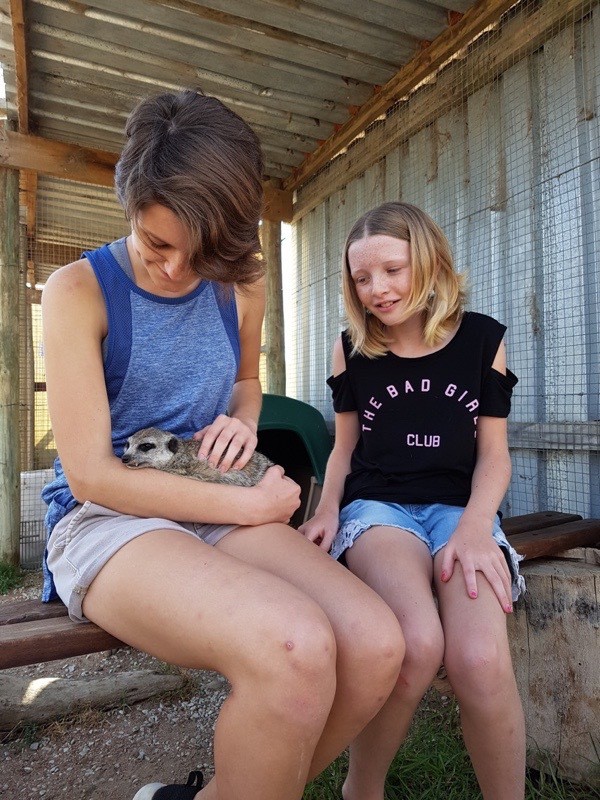
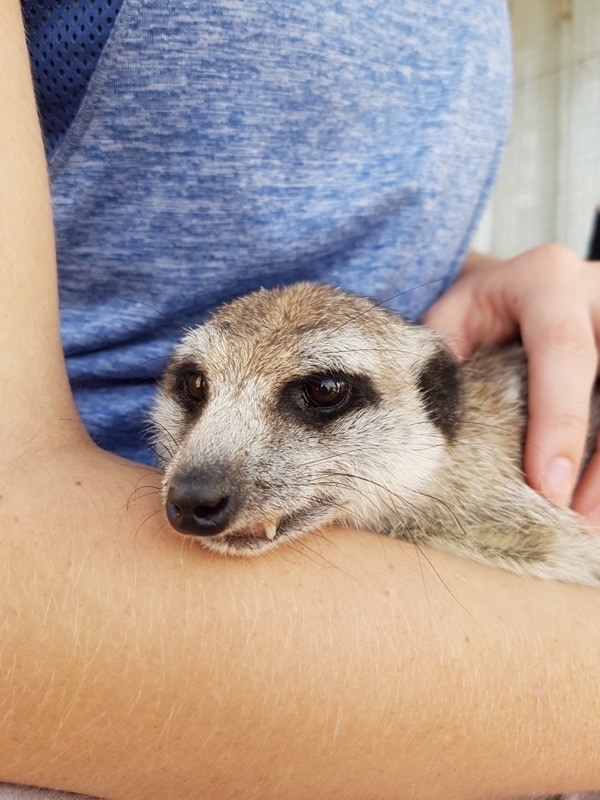

We were also able to see a whole family of turtles. Can’t remember their breed, but they live to be up to 100 years old and get to about the size of the adult pictured below in the wheel barrow. Of course, they have nothing to do with the cheetahs but everything to do with finding an abandoned animal and deciding to help it out. We watched the very ambitious little baby turtles for awhile and we laughed when we heard on the walkie talkie that the staff were only able to find 14 of the 15 of them. Turtle MIA!
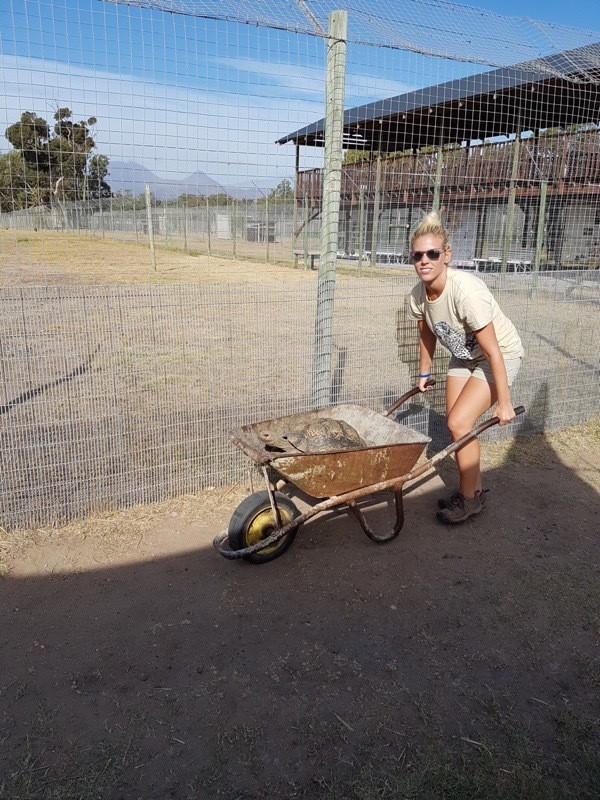
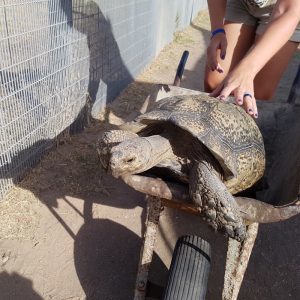
Next up, the star of the show. Cheetahs! The cheetahs they have were born in captivity and hand-raised. They are not able to be released into the wild because their instincts necessary to survive are not be as strong as they need to be. This organization does not condone the capture of cheetahs. However, they do realize that it’s a big tourist draw to pet and take pictures with a cheetah. Since tourists won’t pay enough money to see a dog being raised, having cheetahs is a necessary aspect of the ability to raise funds for the program which in turn, supports the raising of the protection dogs, which ends up supporting the survival of wild cheetah populations. So they managed to secure a few of the cheetahs born in captivity and had them available for human encounters.
It’s quite the ordeal to interact with them. You don’t just come into the pen and start petting. There is a very strict protocol of removing all distractions like sunglasses, jewelry and no cameras or phones. The trainer will take one phone from the group and take pictures for you, but you can’t do it yourself. There is a square bucket you have to step into that contains an antiseptic agent which cleans the bottoms of your shoes. Since we’re walking into their enclosures, they want to make sure we’re not bringing into their habitat something that might compromise their immune system. Speaking of, one of the problems the cheetah species is having is a lack of gene diversity. They said that if you compare the DNA of a cheetah in China to one in South Africa, they will be very closely related. So this has made the entire species very vulnerable to disease, due to it’s lack of genetic diversity.
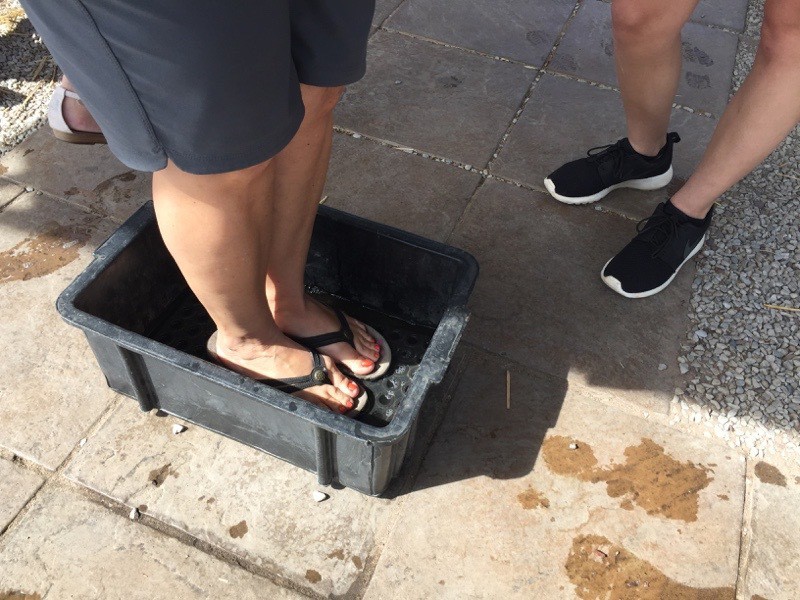
Anyway, we followed their instructions very carefully and we went in and pet the cheetah. Did you know that these big cats purr, just like little ones around your house!? Only much much louder. It didn’t sound nearly as friendly as their domesticated brethren, but they assured us that the cheetah was relaxed. It was a well oiled operation. Three handlers were there with us the entire time and it was clear that these cheetahs were not any kind of circus animal. They were true predators and despite being raised around humans, they still had to be watched carefully to see if they were relaxed and non aggressive in order to allow humans to come in and pet them. We were specifically told how to approach them, how to sit, where to pet them, how to pet them and when to get up if the cheetah appeared unhappy. As we finished our encounter they were putting away the cheetah who seemed to have had enough for the day and they were fetching his brother who looked a little more open to human company at that moment.
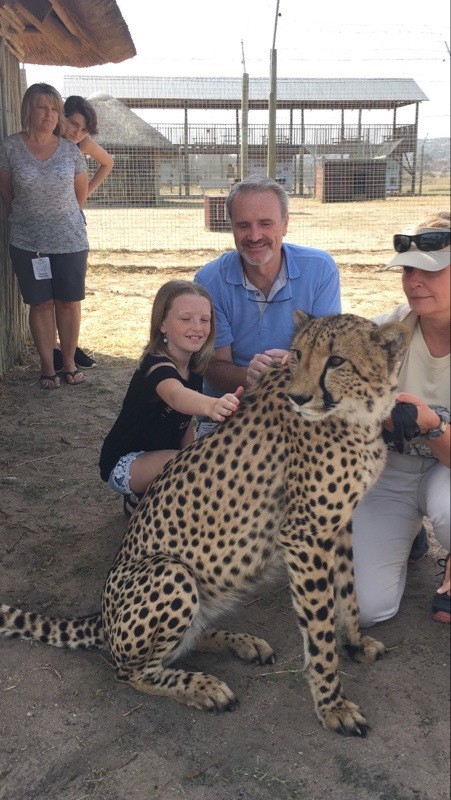
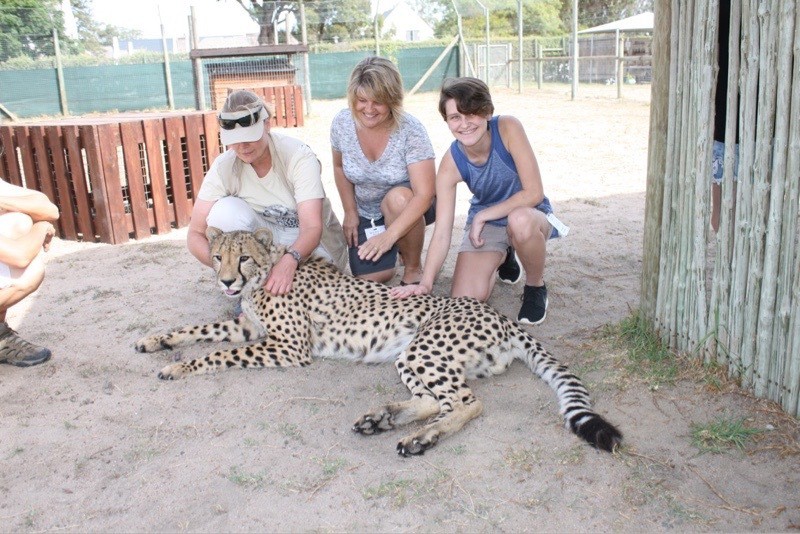
The entire experience was incredibly educational and I felt it was very well done. It was not slick or fancy or polished but it was clear they truly had a love for cheetahs and were doing all they could to address the declining population. We stayed long enough to watch the afternoon feeding, including whole rabbit heads (fur still on) going to one of the smaller cats. At that point, the girls decided they had seen enough and we went home to our own cheetah.


